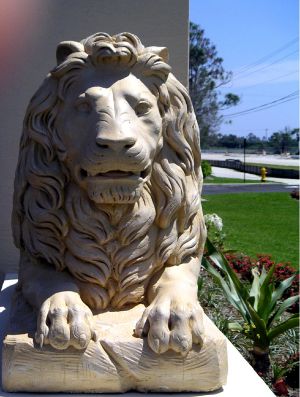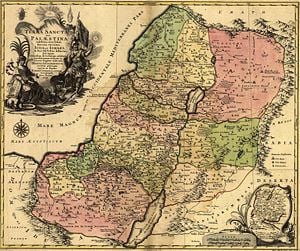Tribe of Judah
Template:Tribes of Israel
The Tribe of Judah ( Standard Hebrew Yəhuda, "Praise") is one of the Hebrew tribes, founded by Judah, son of Jacob. Judah's wife Tamar, who was originally his daughter-in-law, played a key role in the continuation of Judah's lineage.
Together with the Tribe of Benjamin and elements of the Tribe of Levi, the descendants of Judah eventually formed the southern Kingdom of Judah in the ancient Land of Israel. These two tribes were not carried into captivity and "lost" with the ten tribes of the northern Kingdom of Israel when it fell to the Assyrians. Instead the people of Judah were exiled to Babylon a century later, but were able to return and rebuild their nation. In time the tribe of Judah became identified with the entire Hebrew nation, and gave it name to the people known today as the Jews.
In the Bible
The tribe of Judah descended from the patriarch Judah, the fourth son of Jacob and Leah (Gen. xxix. 35). Judah's daughter-in-law Tamar played a pivotal role in ensuring the survival of Judah's lineage, giving birth the the twins Peres and Zerah. Judah and his three surviving sons went down with Jacob into Ancient Egypt (Gen. 46:12; Ex. 1:2). By the time of the Exodus they had increased to the number of 74,000 males (Num. 1:26, 27). In the Book of Numbers, Judah is represented as sharing with the other tribes the experiences of the Exodus and of the sojourn in the wilderness. The clans which then composed the tribe are said to have been the Shelanites, Perizzites, Zerahites, Hezronites, and Hamulites (Num. xxvi. 19-22). This tribe marched at the van on the east of the Tabernacle (Num. 2:3-9; 10:14), its standard, as is supposed, being a lion's whelp.
Caleb, the son of Jephunneh, represented the tribe as one of the spies (13:6; 34:19). Under Caleb, during the wars of conquest, Judah conquered that portion of the country which was later assigned to it as its inheritance. (Josh. 14:6-15; 15:13-19).
The inheritance of the tribe of Judah was at first fully one-third of the whole country west of the Jordan River, in all about 2,300 square miles (Josh. 15). However, a later distribution gave Simeon about 1,000 square miles out of the portion of Judah (Josh. 19:9). That which remained to Judah was still very large in proportion to the inheritance of the other tribes.
The boundaries of the territory are described in Josh. 15:20-63. The territory is said to have extended south as far as Kadesh Barnea, about 50 miles south of Beersheba and west as far as Gaza, Ashdod, and Ekron. Even after the supposed conquest, this allotted Judah a terriority that included lands and fortified cities still under control of the Philistines, Jebusites, and other Canaanite peoples, with whom they would struggle for centuries.
From the Book of Judges (1:16) it is learned that the non-Israelite people known as the Kenites united with Judah and apparenetly became a clan of the tribe. To these clans the two Kenizzite clans of Caleb and Othniel appear to have been added (ib. i. 12-15, 20; Josh. xiv. 6-15, xv. 13-19). Closely connected with Caleb was Jerahmeel, who is said to have been Caleb's brother (I Chron. ii. 42). In I Sam. xxvii. 10, xxx. 29, the Jerahmeelites appear to be a part of the tribe of Judah; they are therefore to be regarded as another clan of the tribe.
After the settlement in Canaan, Judah seems to have stood apart from the other tribes. It is not mentioned in the song of Deborah (Judges v.); and in the accounts of the kingdom of Saul it is regularly reckoned separately from the other tribes (comp. I Sam. xi. 8, xvii. 52, xviii. 16). Upon the death of Saul, David erected the tribe of Judah into a separate kingdom (II Sam. ii. 1 et seq.). As the house of Saul under the weak Ish-bosheth maintained its supremacy over the remaining tribes but seven and one-half years, Judah was after that time reunited to Israel under her own king, David. This union continued for eighty years, through the reigns of David and Solomon. For the further history of the tribe see Judah, Kingdom of.
Modern descendants
Most Jews are descended from this tribe.[1][2][3][4]
According to Judeo-Christian belief, The Messiah came out or will come out of the tribe of Judah. "The staff shall not depart from Judah, nor the sceptre from between his feet..." (Genesis 49:10)
Notable members
- Judah, Biblical eponymous ancestor of the tribe
- Perez, his son.
- Nachshon, a chieftain from the time of the Exodus.
- Caleb, military leader from the time of the Exodus, and his brother Kenaz.
- Othniel, leader from the period of the shoftim and son of Kenaz.
- Possibly the judge Ibzan (but see that article for controversy).
- Boaz, Obed, and Jesse, the great-grandfather, grandfather and father, respectively, of King David.
- David, king of Israel and founder of the Davidic line.
- The Kings of Judah who were descended from David (but not the later Hasmonean kings of Judea, who were Levites of the priestly caste.
- The prophets Amos, Habakkuk, Isaiah, Jeremiah, Joel, Micah, Obadiah, Zechariah, and Zephaniah.
- Shealtiel and Zerubabel, figures of the Babylonian Exile.
- Hachaliah
- Nechemiah, governor of Judea under the Achamenid Persian Empire.
- The Exilarchs and the Nasi'im of the House of Hillel.
- Jesus Christ according to the genealogy of Matthew 1:1
catergory:history
Credits
New World Encyclopedia writers and editors rewrote and completed the Wikipedia article in accordance with New World Encyclopedia standards. This article abides by terms of the Creative Commons CC-by-sa 3.0 License (CC-by-sa), which may be used and disseminated with proper attribution. Credit is due under the terms of this license that can reference both the New World Encyclopedia contributors and the selfless volunteer contributors of the Wikimedia Foundation. To cite this article click here for a list of acceptable citing formats.The history of earlier contributions by wikipedians is accessible to researchers here:
The history of this article since it was imported to New World Encyclopedia:
Note: Some restrictions may apply to use of individual images which are separately licensed.
- ↑ Glossary of terms related to Judaism based on the GLOSSARY for the Study of Judaism, Christianity, and Islam version 9301 (1993 January), uncopyrightable factual information. Prepared initially by Robert A. Kraft, University of Pennsylvania, and intended to be used freely in the public domain in this and any updated versions (based partly on materials from introductory textbooks by Phillip Sigal, Jacob Neusner, Michael Fishbane, Sandra Frankiel, R. Dean Peterson, Frederick Denny, Kenneth Cragg, F. E. Peters)
- ↑ Who Is a Jew? Origins of the Words "Jew" and "Judaism" (jewfaq.org)
- ↑ Where does the word "Jew" come from? by Rabbi Naftali Silberberg (askmoses.com)
- ↑ Biography of Judah (Chabad)

